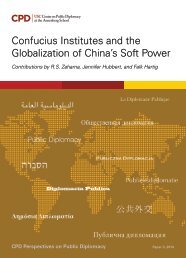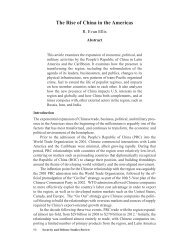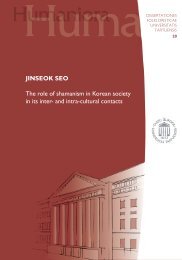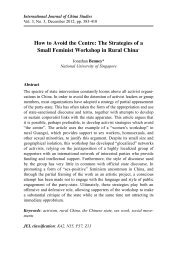JennyChan.PhDThesis.2014.FINAL
JennyChan.PhDThesis.2014.FINAL
JennyChan.PhDThesis.2014.FINAL
Create successful ePaper yourself
Turn your PDF publications into a flip-book with our unique Google optimized e-Paper software.
what ways do the interns, or “student workers,” understand their internships on the<br />
line? Government education departments demand that vocational schools send<br />
students to labor-wanting Foxconn factories. Schools become the labor contractors.<br />
The abuse of intern labor and migrant workers is a result of collusion among the<br />
local state, company, and global buyers in capitalist accumulation.<br />
Production and consumption are interconnected spheres. Chapter 7 discusses<br />
workers’ social and family lives as well as their living conditions in the city. Factory<br />
dormitories as physical and socio-cultural spaces are potential resources in labor<br />
mobilization, though they are also tools for managerial control. They are a frequently<br />
negotiated site of contestation between labor and capital, and a place emergent from<br />
the withdrawal of the local government from worker housing provision. Outside of<br />
employer-provided dormitories designed primarily for individual worers, migrant<br />
families who bring children with them to the city face a heavy financial burden<br />
securing housing. Decent work and upward social mobility remains a distant<br />
“Chinese Dream” for many.<br />
Chapters 8 and 9 document lawsuits and extra-legal activisms waged by aggrieved<br />
workers to defend their dignity and rights. While class consciousness is situational<br />
and transient in nature, at times of crisis the awakening of consciousness is<br />
heightened, and this can be observed in workers’ slogans, poems, and open letters.<br />
Despite severe limitations, Foxconn workers employ a wide array of organizing<br />
strategies and tactics of resistance, including taking their boss to court, going on<br />
strike, rioting, threatening mass suicides, organizing a slowdown on the assembly<br />
line, and staging protests at the factories and in the dormitories. These instances of<br />
individualistic and/or collective conduct serve to protect one’s class interest as well<br />
as moral status (such as the right to human respect and negotiation on an equal<br />
footing). Local government officials react quickly to break the workers’ front in<br />
high-profile incidents. Workers face a formidable alliance of capital, including<br />
international capital, and the Chinese state, but also demonstrate their strong<br />
capacities for class actions.<br />
My conclusion (chapter 10) highlights the contributions of this labor study and the<br />
social transformation at the grassroots level in global capitalism. Some workers have<br />
accumulated organizing skills and public communications techniques in successive<br />
struggles. Meanwhile, the geography of production is changing. As capital moves<br />
rapidly to central and western regions, workers are now living closer to their native<br />
place, and they can draw on local family and social networks to make their demands.<br />
20






